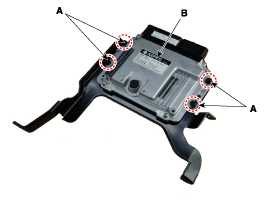Hyundai Sonata LF: Engine Control System / Engine Control Module (ECM) Repair procedures
| Removal |
When replacing the ECM, the vehicle equipped with immobilizer must be performed the procedure as below.
[In the case of installing used ECM]
[In the case of installing new ECM]
Then the ECM key register process is completed automatically.
|
| 1. |
Turn ignition switch OFF and disconnect the negative (-) battery cable. |
| 2. |
Disconnect the ECM Connector (A).
|
| 3. |
Remove the air cleaner assembly.
(Refer to Engine Mechanical System - "Air Cleaner") |
| 4. |
Remove the mounting bolts (A) and nut (B), and then remove the ECM (C).
|
| 5. |
Remove the ECM (B) after removing 4 nuts (A) from the bracket.
|
| Installation |
When replacing the ECM, the vehicle equipped with immobilizer must be performed the procedure as below.
[In the case of installing used ECM]
[In the case of installing new ECM]
Then the ECM key register process is completed automatically.
|
| 1. |
Install in the reverse order of removal.
|
| ECM Problem Inspection Procedure |
| 1. |
TEST ECM GROUND CIRCUIT: Measure resistance between ECM and
chassis ground using the backside of ECM harness connector as ECM side
check point. If the problem is found, repair it.
|
| 2. |
TEST ECM CONNECTOR: Disconnect the ECM connector and visually
check the ground terminals on ECM side and harness side for bent pins
or poor contact pressure. If the problem is found, repair it. |
| 3. |
If problem is not found in Step 1 and 2, the ECM could be
faulty. If so, make sure there were no DTC's before swapping the ECM
with a new one, and then check the vehicle again. If DTC's were found,
examine this first before swapping ECM. |
| 4. |
RE-TEST THE ORIGINAL ECM: Install the original ECM (may be
broken) into a known-good vehicle and check the vehicle. If the problem
occurs again, replace the original ECM with a new one. If problem does
not occur, this is intermittent problem (Refer to “Intermittent
Problem Inspection Procedure” in Basic Inspection Procedure). |
 Engine Control Module (ECM) Schematic Diagrams
Engine Control Module (ECM) Schematic Diagrams
ECM Terminal And Input/Output signal ECM Terminal Function Connector [C500-A] Pin No.DescriptionConnected to1Injector (Cylinder #3) [High] control outputInjector (Cylinder #3)2Injector (Cylinder #4) [High] control outputInjector (Cylinder #4)3Injector (Cylinder #2) [Low] control outputInjector (Cylinder #2)4Electric Waste Gate Actuator (EWGA) DC Motor output (+)Electric Waste Gate Actuator (EWGA) 5Heated Oxygen Sensor (HO2S) [Bank 1/Sensor 1] heater control outputHeated Oxygen Sensor (HO2S) [Bank 1/Sensor 1]6-?7-8-?9Sensor ground Electric Waste Gate Actuator (EWGA) 10-?11-?12-13-?14Cooling fan relay [High] control outputCooling fan relay [High]15CVVT Oil Control Valve (OCV) [Bank 1/Exhaust] control outputCVVT Oil Control Valve (OCV) [Bank 1/Exhaust]16Injector (Cylinder #2) [High] control outputInjector (Cylinder #2)17Injector (Cylinder #1) [High] control outputInjector (Cylinder #1)18Injector (Cylinder #3) [Low] control outputInjector (Cylinder #3)19Electric Waste Gate Actuator (EWGA) DC Motor output (-) Electric Waste Gate Actuator (EWGA) 20Heated Oxygen Sensor (HO2S) [Bank 1/Sensor2] heater control outputHeated Oxygen Sensor (HO2S) [Bank 1/Sensor 2]21-?22-?23Engine Coolant Temperature Sensor (ECTS) signal inputEngine Coolant Temperature Sensor (ECTS)?24Sensor groundEngine Coolant Temperature Sensor (ECTS) 25-?26Fuel Tank Pressure Sensor (FTPS) signal inputFuel Tank Pressure Sensor (FTPS)27Fuel pump relay control output (NON-Smart key type)Fuel pump relayCanister Close Valve (CCV) control output (Smart key type)Canister Close Valve (CCV)28-?29-30-?31Ignition coil (Cylinder #3) control outputIgnition coil (Cylinder #3)32Ignition coil (Cylinder #1) control outputIgnition coil (Cylinder #1)33Injector (Cylinder #1) [Low] control outputInjector (Cylinder #1)34Fuel Pressure Control Valve (FPCV) [High] control outputFuel Pressure Control Valve (FPCV)35ETC motor [-] control outputETC motor36-?37Knock Sensor (KS) signal inputKnock Sensor (KS)38Sensor groundKnock Sensor (KS)39-40Brake Light switch signal inputBrake switch41-42-43-?44-?45CVVT Oil Control Valve (OCV) [Bank 1/Intake] control outputCVVT Oil Control Valve (OCV) [Bank 1/Intake]46Ignition coil (Cylinder #4) control outputIgnition coil (Cylinder #4)47Ignition coil (Cylinder #2) control outputIgnition coil (Cylinder #2)48Injector (Cylinder #4) [Low] control outputInjector (Cylinder #4)49Fuel Pressure Control Valve (FPCV) [Low] control outputFuel Pressure Control Valve (FPCV)50ETC motor [+] control outputETC motor51-?52Electric Waste Gate Actuator (EWGA) Feed beck signal Electric Waste Gate Actuator (EWGA) 53Brake Test switch signal inputBrake switch54-?55-56Electric load signal input [Defrost]Alternator57Alternator COM signal outputAlternator58Engine speed signal outputCluster59Cooling fan relay [Low] control outputCooling fan relay [Low] 60- Connector [C500-K] Pin No...
 ETC (Electronic Throttle Control) System Description and Operation
ETC (Electronic Throttle Control) System Description and Operation
Description The Electronic Throttle Control (ETC) System consists of a throttle body with an integrated control motor and throttle position sensor (TPS)...
Other information:
Hyundai Sonata LF 2014-2019 Service Manual: Front Disc Brake Components and Components Location
C..
Hyundai Sonata LF 2014-2019 Service Manual: Power Door Mirror Switch Repair procedures
Inspection [Power Window Module (IMS)] 1. Disconnect the negative (-) battery terminal. 2. Remove the front left door trim. (Refer to Body - "Front Door Trim") 3. Disconnect the power mirror switch connector from the door trim. 4. Check for continuity between the terminals in each switch position according to the table...
Categories
- Manuals Home
- Hyundai Sonata Owners Manual
- Hyundai Sonata Service Manual
- Engine Electrical System
- Cooling System
- Audio
- New on site
- Most important about car




